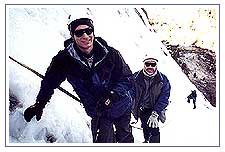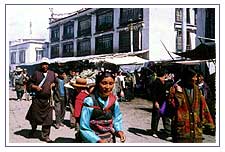Nepal - a country of amazing extremes, is the home of the World's
highest mountains, historic cities and the forested plains where the lordly
tigers and the great one-horned Rhinoceros trundle at ease. in fact
enchantment is everywhere for anyone in search of Shangrila!
Nepal, a sovereign independent Kingdom, is bounded on the North by the
Tibetan Autonomous Region of the People's Republic of China, the
East-south and West by India. The length of the kingdom is 885-kms East-West
and it's breadth varies from 145-241-kms North-South. The country can
be divided into three main geographical regions:
Nepal Himalaya Region:
The altitude of this region ranges between
4877-m.- 8848 m. it includes 8 of the highest 14 summits in the world, which
exceed altitude of 8,000m including Annapurna, Dhaulagiri and others.
Nepal Mountain Region:

This
region accounts for about 64% of total land area. It is formed by the
Mahabharat range that soars up to 4,877m and the lower Churia range.
Nepal Terai Region:
The low-land Terai occupies about 17% of the
total land area of the country.
History Of Nepal
Nepal - a country with a long historical tradition is
an amalgamation of a number of medieval principalities. Before the campaign
of national integration launched by King Prithivi Narayan Shah the Kathmandu
valley was ruled by the Malla kings, whose contributions to art and culture
are indeed great and unique. In 1768 A.D. the Shah dynasty ascended the
throne of the unified kingdom. His majesty king Birendra Bir Bikram Shah
Dev, was tenth king in the Shah dynasty.
The new democratic constitution of the kingdom was promulgated on November
9, 1990. Nepal is one of the founder members of South Asian association for
Regional Cooperation or SAARC, of which the third summit was held in
Kathmandu in November 1987
Nepalese People
Nepal has a population of more than 18 million people
made of different races living in different regions with diverse culture,
languages and dialects. The Gurungs and Magars live mainly in the west. The
Rais, Limbus and Sunuwars inhabit the slopes and valleys of the eastern mid
hills. The Sherpas live in the Himalayan region. The newars constitute an
important ethnic group of the capital valley Kathmandu. There are Tharus,
Yadavas, Satar, Rajvanshis and Dhimals in the Terai region. The Brahmans,
Chhetris and Thakuris are spread generally over all parts of the kingdom.
Hinduism and
Buddhism constitute two major religions of Nepal. A remarkable feature of
Nepal is the religious homogeneity what exists, particularly between the
Hindu and Buddhist communities. Apart from the Hindus and Buddhists, Muslim
from the third largest religious group.
The exquisite medieval art & architecture of the Kathmandu valley
vividly reflect the artistic ingenuity and the religious tradition of the
people.
Nepal has four climatic seasons
(a) Spring : March-May
(b) Sumer: June-August
(c) Autumn: September-November
(d) Winter: December-February.
There is no seasonal constraint on travelling in and through Nepal. Even in
December and January, when the winter is at its severest, there are
compensating bright sun and brilliant views.
Air:
There are 15 International carriers operating to and out of Kathmandu
International airport. There are ten passenger airlines operating to almost
30 destination in nearly all parts of Nepal - remote airfields to major hub
cities. Today it is possible to reach most of the tourist destinations by
air. Some of the major tourist destinations in Nepal operated by domestic
airlines are:
Helicopter
Services:
Nepal with its high mountains and beautiful scenic countryside is known as "Helicopter
Country." The helicopter services industry in Nepal is now well
established with many types and categories of helicopters. The pilots are
very experienced professionals with thousands of flying hours experience in
Nepal.
Rail:
Nepal-Janakpur-Jayanagar Railway (NJJR) operates a freight and passenger
service in the eastern Terai.
Roads:
Buses, mini-buses and three-wheeler tempos ply on fixed routes at regular
intervals. The services, are fairly frequent. The last city buses stop
running around 8 pm. City buses that ply within Kathmandu and go to Patan as
well as those going to Kirtipur, Banepa, Dhulikhel and Thankot, leave from
the City Bus Park located at the eastern side of Tundikhel parade ground.
Trolley buses to Bhaktapur leave from Tripureswor near the football stadium.
Their are no international Car Rental agencies in Nepal and even the locals
usually have a driver assigned to their personal car rather than deal with
the terrible traffic conditions around the city.
General Info on Nepal
Language:

Nepali,
serves the purpose of the Kingdom's Lingua-Franca in Nepal. The
educated people speak and understand English as well.
Clothing:
Clothing depends on place and time, however, it is recommended to have both
light and warm clothing. In the mountain areas warm clothes are generally a
must.
Licensed Guides:
All the travel agencies of Kathmandu have licensed English speaking guides,
however, many agencies have also guides who can speak other international
languages for the convenience of tourists. As unlicensed guides are not
allowed to serve clients, it is advisable to confirm that your guide has
valid license. To have a quality service it is recommended to arrange the
sightseeing programmes only through the government registered travel
agencies.


 This
region accounts for about 64% of total land area. It is formed by the
Mahabharat range that soars up to 4,877m and the lower Churia range.
This
region accounts for about 64% of total land area. It is formed by the
Mahabharat range that soars up to 4,877m and the lower Churia range.
 Nepali,
serves the purpose of the Kingdom's Lingua-Franca in Nepal. The
educated people speak and understand English as well.
Nepali,
serves the purpose of the Kingdom's Lingua-Franca in Nepal. The
educated people speak and understand English as well.